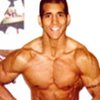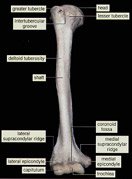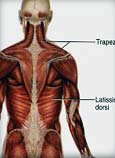Note: Click Here To Read 'The Pecs'.
For the past few years I have taken upon my self to learn as much as possible about the human body, both from a structural and a bio-chemical stand point. Not only from textbooks, but also from outside research. I'm sure some of you have seen some of my posts on the message boards and I tend to leave references to studies that verify my claims and beliefs.
I love to learn about the workings of the body and how we can influence it to our liking. From what we do in the gym to the things we eat at certain times. I'm constantly looking for ways to improve my self and to help others as well.
In my first article I gave a little nutritional tip that anyone can do to enhance muscle recovery and growth. My second article focused on debunking the belief that cardio doesn't have a place in building maximum muscle. In this article I'm going to focus on how to make your Back workouts more effective.
Anyone who has taken a class in the life sciences has heard the phrase "Structure = function". Well, this does apply in the gym and to building muscle. For a bodybuilder, a back workout most often targets the "lats". Just by understanding how the lat is shaped, connected to our skeleton and its main job, we can make every work out twice as productive.
First off, the back is comprised of dozens of muscles and there is no way to actually "isolate" any specific one, nor is there any particular set of exercises that will add thickness over width or vice versa. However, many of the deep muscles in the back are stabilizers of the spine and trunk. So when we work our lats with heavy free weight exercises, we indirectly stimulate them all.
STRUCTURE
The Latissimus Dorsi is a large "fan-like" muscle that covers those dozens of muscle that I mentioned earlier, it is therefore called, superficial. Its place of origin, or where it starts, begins at the middle of the back at the vertebrae T5-T7, the lower three ribs of the rib cage, the iliac crest (the hip), and the inferior angle of the scapula. That's a big muscle! And the whole thing runs to one single spot.
It runs up under the armpit and reaches around to your arm in between two small bumps called the intertubercular groove. This "groove" is at the top of the humerus bone in very close proximity to the "ball" of the ball-and-socket joint of the arm. The long head of the biceps muscle runs right over this and the short head runs right along the side of it. So just by understanding that bicep recruitment is inevitable, trying to cut the biceps out of the picture with various hand placements is a mood point.
And to be quite honest, doing so will only lessen the amount of stimulation directed to the lat muscles themselves. For the elbow to bend, the biceps must contract. It is that simple.
After going through many of the anatomy classes that I have, I have come to one very simple conclusion: There isn't one muscle that was meant to work alone, thus any exercise that is an attempt to "isolate" is useless. Muscles are meant to work in a synergistic fashion and we should keep that in mind when we put together a workout routine.
FUNCTION
So we have an idea of what this bad boy looks like and how it connects to our skeleton. And just by knowing that we can figure out what it does. By understanding that all a muscle contraction is, is a shortening of the fibers and that they shorten in the direction of insertion to origin (for the most part), we should be able to make sense of it.
By definition the job of the lat is to Extend, Adduct, medially rotate arm and draw shoulder inferiorly. What the hell does that mean? Well basically to pull the arm down, back and keep the elbows close to the body. "Draw the shoulder inferiorly" is a little different. If you were to fully extend your arms overhead as high as you could as if you were stretching, you would be able to pull arm down about 2 inches with out actually bending it.
Or pull your shoulder toward the ground. And this works in both ways, down if your arms are up and backward if your arms are down. Think of a bodybuilder going into a rear lat spread. The first thing one normally does is flex the lats to bring out the "Christmas Tree". How does he do that? By pulling his shoulders down and back, and drawing his elbows back and keeping them tucked in close to his body. Who says bodybuilders are all muscle and no brains?!?
Effective Training
Effectively training your lats is simple in concept but a little harder to do. For years I trained before I actually felt back exercises in my lats!! I bet there are more than a few of you in that boat right now. And even if I did feel it in my lats, It was nothing in comparison to what its like when you do it right.
To make things very simple, we can go back to the example of a bodybuilder flexing his lats before the rear lat spread. Every Back exercise should end the concentric phase in a position very similar to this. The shoulders back and pressed down, chest out, head pointing straight ahead, and the pelvis tilted forward, or in other words keeping the natural concave curve of the lower back. In fact, you should strive to keep that arch during any lift.
Even when you bench! Keeping the part of your back tight and flexed makes a world of difference. This allows for the mot efficient transfer of power through your body and results in a much greater output of force. So when you see those guys at the gym with their feet up in the air, just take a look at their back. I Guarantee you is pressed flat to the bench and they are struggling with a very little amount of weight.
This is a harder thing to do than you may think. Next time you do a set of heavy pull down, before the first rep, take a minute to set that curve in your low back, and see if you can hold it there for the entire set. Its not an easy task, let me tell you! The next point you want to make sure of, is to keep your elbows as close to your body as possible. This means that your grip should be at shoulders width apart. For most of us, this is much closer than expected. In fact, most people refer to it as a "narrow grip". To get the proper grip width, all you need to do is stand with your hands at your sides and raise them straight up.
Your middle finger should be in line with the AC joint of the shoulder (the bump on top). That's closer than you thought, isn't it? And as I mentioned before, there is no way to exclude the recruitment of the biceps so I feel that we should put ourselves at an advantage. Hand placement should be either neutral or in a supinated grip - palms up.
This allows us to handle more weight, which places a greater stimulus on the lats, which recruits more motor units and there for more muscle fibers. more growth! Having your hands in this fashion also minimizes the elbows from flaring out. This is important because the more your elbows point out, the less your lats are involved and the more the rhomboid groups and other muscles that rotate the scapula. So next time you see some one doing pull downs behind the head, you have my permission to slap them!
The next point is kind of tricky and takes practice. It goes back to the lat muscle's ability to draw the shoulder inferiorly. We want to initiate every movement with the lats. Not with our arms, and not with our low back muscles. So if done correctly the weight should move a few inches before your elbow flexes (your arm bends). So, on a pull up you should go from a full hang and be able to raise your body a little before your arms come into play. And on a pull down, you should be able to lift the stack a few inches before leaning back too much or bending your arms.
RANGE OF MOTION
Getting a full range of motion seems to be a problem one way or another. People either go too far or not far enough. Pull downs is easy enough, from arms fully extended and your torso upright, to bringing the bar down to touch your mid/upper chest area. And from the fully extended position, you need to remember to start the movement with your lats, not your arms or lower back.
It is ok to lean to a 30-450 angle, but remember you are working your lats here, not your lower back. There is a fine line between what is enough and what is too much. It will take some time to feel out how much that is. From personal experience, if after your working set, your lats aren't flooded with blood, it was too much.
Rows, however, are a different story. Cable row, for example, people tend to be too sloppy by rounding their back to get a stretch and pulling the weight with the low back first. Or, they are too strict and stay way too rigid to get any stretch. You should lean forward to about 450, but again, you have to maintain the natural curve of the spin in the lower back. This does take practice. And of course you must start the weight with your lats, so the weight should move slightly before your arms bend or you lean back into it. So, in a sense, move the weight by flexing your lats as hard as possible!
On BB and DB rows, many people bring the weight much to high and this shifts the tension to other supporting muscles. As I stated before, the end of the concentric phase should look like a bodybuilder before a rear lat spread. So your elbows should only go about 2-3 inches beyond your body. On BB row you do not need to try and jam the bar into your gut! Keep you knees slightly bent, lean forward about 450, and lock your hips in place, they should not move.
With heavy weight there will always be a little movement of the back, but the hips should stay in place, in other words, don't stand up. For DB row, the weight should come up to your hip pocket and the lower region of your rib cage, much like you were holstering a gun.
WRIST WRAPS
The issue of wrist wraps is an ongoing debate that will probably never end. So, I will start by saying its really a matter of preference. But I think there are a couple things you should take into mind. The first being your purpose for training. If you are a bodybuilder looking to stimulate the most amount of muscle growth, I firmly believe that wraps should be used. The lats are strong and powerful.
Your grip will give way before they do. You want to focus all of your attention onto your lats and if you need to worry about holding on to the bar, you will inevitably use your arms too much. I feel that for all heavy back work wraps should be used. View your hands as a hook that is just there to connect the lats to the weight. You can work your fore arms directly some other time.
However, if you are an athlete training for a sport that involves hand strength, like football, wrestling, rugby, etc. Then I don't think you should ever use wrist wraps regardless of what you are working. Weather it be your back, traps or whatever, I would stay away from wraps as much as possible.
Finally, I must say that I don't think one should be come dependant on them either. Use them only when you need to, i.e. for your heavy working sets. Especially during the hot and humid months when you will tend to sweat a bit more making the bar even harder to hold on to.
Well, as you can see, the latissimus dosi is a simple muscle in looks, but complex in function and even more complex to work effectively. I hope that this article has shed some light on the finer details or effective back training. Give these little things a try, I bet you'll find that your back workouts will be twice as intense as before.
Note: Click Here To Read 'The Pecs'.
Thanks,


